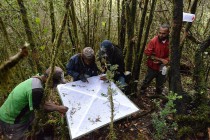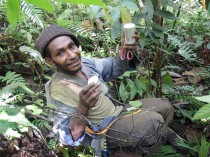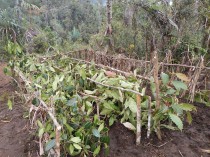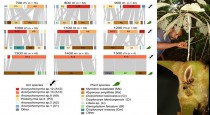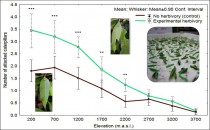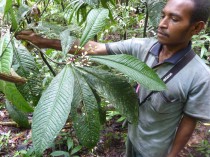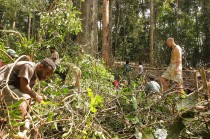Research

There are endless opportunities for research along the transect, including surveys of extremely diverse but poorly known plant and animal taxa and communities, studies of population dynamics and distribution of plant and animal species responding to climate change (including the effects of El Nino), studies of inter-specific interactions, including food webs, and many others.
The slash-and-burn agriculture practiced by indigenous farmers provides opportunities to manipulate and clear forest vegetation, and study ecological succession. Altitudinal gradient is also suited to experimental relocation of species to novel altitudes, in order to model their response to climate change.
There are also opportunities for the study of traditional agriculture (farmers along the transect grow 97 species of crops), anthropology and linguistics.
Examples of some ongoing research projects:
1. Quantitative surveys of elevation trends
Quantitative surveys of elevation trends in species richness and abundance of various taxa (birds, bats, frogs, ants, butterflies, moths, leafhoppers, beetles, fruit flies, ferns, trees) – see examples in the Biodiversity section. A multi-taxon survey of Mt Wilhelm biodiversity was a part of Our Planet Reviewed project in 2012-2013.
2. Surveys of plant-herbivore food webs. L. Sam et al.: Ficus and folivorous herbivores
3. Food webs on Ficus hosts translocated to novel elevations (L. Sam et al.)
4. Elevational trends in plant-ant mutualist webs (N. Plowman et al.)
5. Predation pressure on model caterpillars feeding on intact and damaged leaves (K. Sam et al.)
Rate of attack (mostly by birds and ants) on plasticine caterpillars: caterpillars are safer on intact than damaged foliage, and predation pressure decreases with elevation.
6. Effect of predation by birds, bats and ants on insect communities (K. Sam et al.)
Density of insects (relative to a control) after one year of bird and bat exclusion, using a net exclosure: increased to 180% of original values in the lowlands and 120% at the timber line.
7. Phylogeny of Pleistodontes fig wasps (Segar et al.)
We are building a phylogenetic hypothesis for the endemic Australasian fig wasp genus Pleistodontes.
8. Population genetics of figs and fig wasps (Segar et al.)
Assessing the barriers to gene flow between lowland and montane populations of Ficus trees.
9. Elevational turnover in defensive investment by fig trees (Segar et al.)
10. Functional relationships between fruits and frugivorous birds (R. Hazell et al.)
Investigating the relationships between functional traits of fruiting plants and frugivorous birds along the transect, both at the scale of individual species interactions and of the community as a whole.
11. Plant-Herbivore food web structure and dynamics along altitudinal and succession gradients (Redmond et al.)
Sampling of entire 0.2ha forest plots in primary and secondary forest at three elevations – so far at Numba, 900 m asl. – and mapping the interactions between plants and caterpillars.
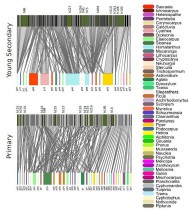
Interaction networks in 0.2 ha of early secondary and primary forests (plant species at the bottom, caterpillar species on top)
11. Socio-ecological surveys to improve the resilience to climate hazards (E. Beauchamp, R. Morris et al.)
The project surveyed six villages to create a baseline of demographic livelihood activities including agricultural practices and further looked into households’ perceptions of the impacts of the 2015 El Niño on their livelihoods, and of how they would change their behaviour under different future scenarios of climate change.
On the ecological side, we have surveyed food gardens at each elevation to collect data on crop yields and pest pressure to investigate whether natural forests can buffer the negative impacts of the El Niño on rural food production, either directly or indirectly.
For more information: link here



